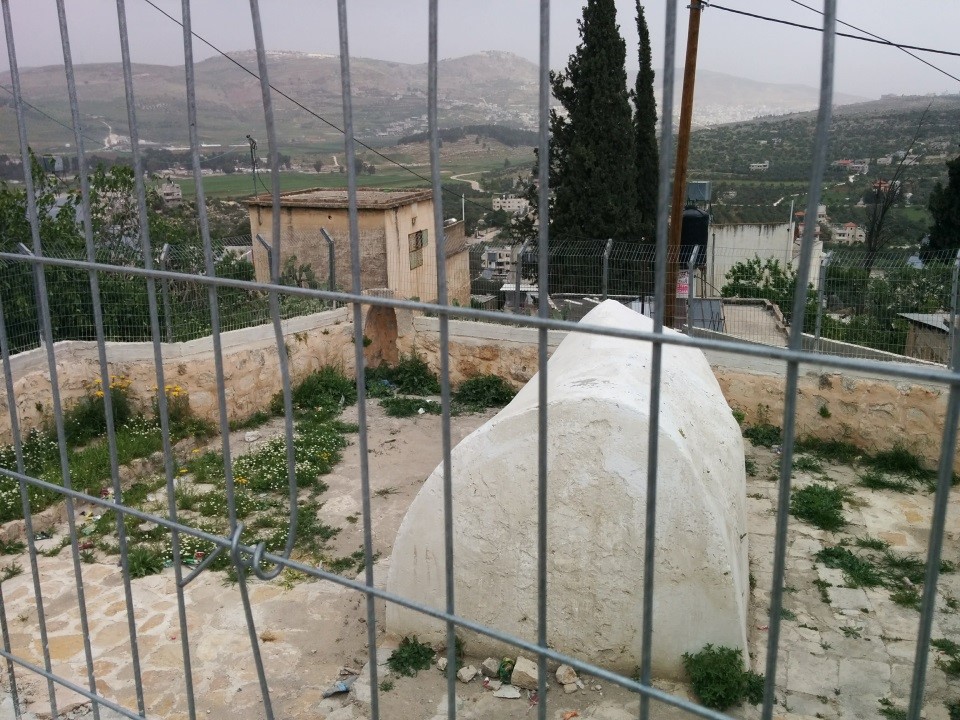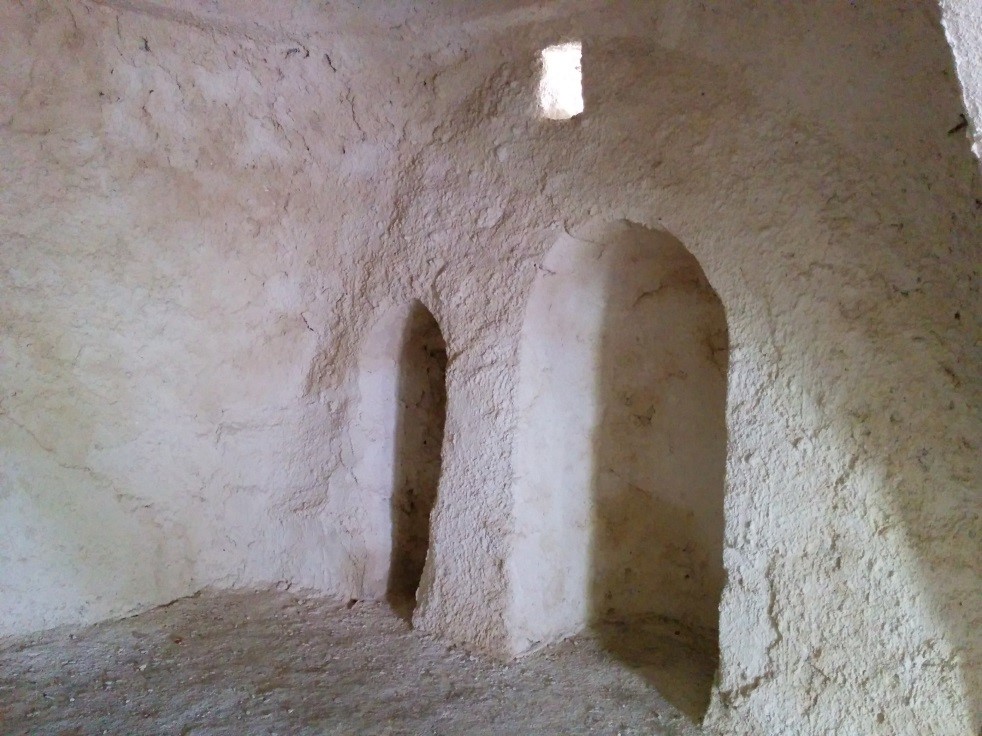Whose are these sacred sites?
The ring of settler-colonies Itamar, Beracha, Yitzhar and their outposts is tightening around the villages of Awarta, Bourin and Kufr Kaleel. Incursions by settler-colonists and soldiers into these villages take place daily: some for mass prayer at the ancient grave sites in Awarta, others with combined forces in order to retrieve a donkey from Bourin…
11:00 We arrived at Awarta, the large (population: 9,000) and ancient village overlooking the hills of Itamar and Beracha. J., a of driver Mustafa, led us to the three famous grave sites, bearing the differing Arabic and Hebrew names. The man was free on Wednesday from his work inside Israel, due to our ‘Feast of Freedom’ (Passover) and their consequent closure .
.
Opposite the grave of Itamar, and its Arabic name Al Mufadhal (the preferred one…) is a taxi station active daily until midnight. We were invited there for coffee and received information from residents of Awarta and Kufr Kaleel.
Whereas the Muslims see the Biblical heroes as figures shared by Muslims, Jews and Christians, the Jews prefer to ignore the signs that indicate who actually built the graves.
We knew of the nightly feasts held at the three grave sites, and wished to find out how this works – with or without coordination? How many times a year? And what about other days and nights? The answers: the great feasts take place twice yearly, from midnight until dawn. About 500 Jewish observants arrive in buses escorted by many soldiers and Border Policemen. There is no coordination (with the Palestinians). If there is a wedding in the village, the buses wait a while, and the villagers who notice this hurry up and end their celebration. Settler-colonists come to the grave sites armed and in separate vehicles but maintain a friendly profile. “Good morning,” they greet the villagers in Arabic. Armed but friendly, take it as you will.
The passage to Nablus (through Abu Ismail Mountain) is free. Ascent to Gerizim Mountain requires coordination with the DCO and the Samaritans. Palestinians have been denied access to the lands and springs of Abu Ismail Mountain for twenty years now. Not even the shepherd from Kufr Kaleel across the road is allowed there. Previously a Messianic Jew lived there for eight years, waiting for the Messiah with his family, horse and buggy. He took care of children who were wounded, free of charge. This is their last pleasant memory from the place. The land of Abu Ismail belongs half to Bourin and half to Kufr Kaleel villages. The figs by the springs belong to Kufr Kaleel. The vines were already planted by settler-colonists.
A 28-year old man, married and father of three, enters the station. He has been trying for three years now to obtain a permit to enter Israel for work. Through Machsomwatch’s Sylvia, too. He is denied permit without any explanation. He has tried to fill every single and absurd bureaucratic demand – including showing his invoices as a trader with an Israeli hardware company – in vain. He has no incriminating record and has never connected with extremists, he said desperately.
From there we traveled on to the double-domed lovely shrine inside the Awarta graveyard. Its name in Arabic is “The 70 Sheikhs”, and in Hebrew “The 70 Elderly Men”. It only shows that such a shrine is no grave but rather a site of prayer honoring a personage or a huge groups of important people.
At the graveyard, an elderly man who asked not to be photographed for fear of the consequences, showed us gravestones that have been damaged by settler-colonists, he says. He himself owns 150 dunams of olive groves in the fertile land of the valley that runs between Awarta and the settler-colony of Itamar. Three days a year are open for him to cultivate, plow and harvest these trees. It does not suffice for anything. Just the plowing itself needs a month and a half.
The largest and best-known of the three graves is that of Nabi Uzair, which we saw first and about which we heard interesting information, having been renovated by a wealthy man from Nablus.
Bourin
We drove to a house at the edge of the village, opposite Saniah Mountain, overlooked from about 700 meters away by Sneh Yaacov settler-colonist outpost. The village is constant prey to settler-colonist harassment, while the Israeli soldiers back them up with teargas and stun grenades. Tonight, too, saw an incident that caused a mother and her daughter to close right all doors and shutters and not sleep a wink. The incident evolved after two villagers climbed up the hill in order to pick some green almonds and collect Akoub weed for cooking. Two soldiers summoned their mates who came up through the village to chase the men. This time we reached the mother and daughter in order to gather information about the violent harassment that took place on Saturday, April 1, 2017, and was filmed.
The excuse? Here is the story: the settler-colonists claimed that a donkey of theirs had been stolen. 30 colonists and about 25 soldiers came down into the village to extricate a donkey. How does one free a captive donkey? One descends into the village with hurled stones, escorted by soldiers who fire teargas and stun grenades to calm the atmosphere… Teargas is no news there. A year ago, the woman’s son along with his wife and baby had to leave their home for fear for the baby’s health. They rented an apartment at the edge of Asira Al Qabaliya village, and now suffer from the Yitzhar settler-colonists’ whims and harassment.
had to leave their home for fear for the baby’s health. They rented an apartment at the edge of Asira Al Qabaliya village, and now suffer from the Yitzhar settler-colonists’ whims and harassment.
A woman-neighbor told us that when her cousin, a shepherd, takes his flock to graze on the top of the hill, the settler-colonists show up immediately, ordering him to back down. According to her, the hill belongs to them and they are not allowed to climb it. (The shepherd is Abu Mursi, whose donkey and several sheep were killed by a settler-colonist near the spring of En Makhne at Abu Ismail Mountain a few years back).
M. honored the people at the house and us with an instructive visit. Bourin, rich with lands and springs, had 6,500 inhabitants until 1967. The picture changed completely after the Israeli occupation. The lands and springs were stolen by Israel, and now the village numbers 3,500 inhabitants, with seriously diminished cultivable lands in Area B. Just this year 100 high-school graduates left Bourin, looking for work all across the globe.
A large demonstration took place at Seniya Mountain in 2014. 3,000 Palestinians from the nearby villages participated. It was dispersed aggressively by 300 soldiers and teargas and stun grenades. The settler-colonists looted all the equipment that was brought to the site (tents etc.) and a letter from the DCO declared the site a ‘closed military area’.
For the past month, in coordination with several people from the village and Fathiya, we have been looking into the possibility of staying there for a few days. It’s not easy to find the right place and format for this. The point is to be a deterrent force rather than merely report post-factum.
The owner of the house built in 1959, as appears on the cornice – the yard contains a perfectly proportioned structure with a rainwater cistern (on the right) and a fish pond in summer on the left. Around the pond were chairs for the inhabitants’ convenience.
The cornice along the house façade includes the date and the owner’s name.

the Muharab, signifies the direction of prayer (Mecca) for Muslims, shows us who built this grave and

Built in honor of the 70 Elderly Men according to the Jews, or the 70 Sheikhs according
pto the Muslims. The Muharab is also double. photo: Irit Segoli 12/4/2017
